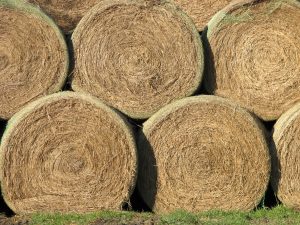 Nationwide, improper hay storage and wasteful feeding methods cause losses of around three billion dollars a year. It is estimated that up to 10% of a farm’s livestock production costs can be traced to inefficient hay management. Proper storage and use will help preserve hay quality, avoiding wasted bales, and provide better nutrition to your horses. Whether you are feeding square or round bales, management of stored hay requires several considerations.
Nationwide, improper hay storage and wasteful feeding methods cause losses of around three billion dollars a year. It is estimated that up to 10% of a farm’s livestock production costs can be traced to inefficient hay management. Proper storage and use will help preserve hay quality, avoiding wasted bales, and provide better nutrition to your horses. Whether you are feeding square or round bales, management of stored hay requires several considerations.
Hay condition at the time of baling is important. Overmature grass contains a large percentage of indigestible fiber and is neither as appetizing nor as nutritious as forage harvested at a less mature stage. Mown hay should be allowed sufficient drying time in the field before baling. Hay that is square-baled at more than 20% moisture or round-baled at more than 18% moisture is subject to mold growth, making it unfit for consumption by horses. There is also a risk of fire due to the heat generated by decomposition.
Hay needs to be stacked so that air can circulate freely as the hay continues to lose moisture. Measures to help ensure proper drying include stacking square bales on edge, leaving narrow gaps between rows of bales, alternating bale orientation in each layer, and keeping stacks no more than four or five bales high. With round bales, care should be taken to avoid stacking too many bales together unless they are well dried. Moisture and heat should be monitored for about two weeks after new hay is stacked in a barn or shed.
A caramel smell may indicate that the hay is becoming hot. A metal pipe or rod driven into the center of the stack can be pulled out from time to time to feel for heat. Hay that is extremely hot or beginning to steam often smolders until the stack is pulled apart, at which time the increased oxygen can cause the bales to burn more rapidly, so caution is advised if there is a reason to suspect this condition.
Stored hay must be protected from ground moisture and rain. A barn loft offers a dry site, but air circulation may be minimal depending on the design of the barn. Stall storage is convenient and safe if the bales are placed on pallets or racks to avoid contact with the ground. Some managers point out the danger of storing flammable hay in a barn where horses are housed, preferring to build separate sheds or barns for hay storage. These structures should be designed to allow easy access to stables and feeding areas, as well as to provide protection from dust, rain, and light. Excessive sun exposure causes a bleached appearance on the top bales, but the discoloration is usually not important if the hay within the bale still appears fresh and green.
Hay can be stored outside if it is stacked on pallets or raised rock pads. Rocks should be 1 to 3 inches (2.5 to 8 cm) in diameter in a layer 4 to 8 inches (10 to 20 cm) above the ground surface. Except in very dry climates, tarps or other coverings are often used to protect bales from dust, sun, and rain. The stack should be designed with a peak at the top or center so that rain will run off instead of pooling. Tarps should be carefully checked for holes or tears and should be weighted or tied so they cannot be blown out of place. Some airflow should still take place to carry away excess moisture in new hay. This can be provided by leaving some open space below the bottom edges of the covering.
Unprotected outdoor storage of round bales inevitably leads to some loss of nutrients. Crude protein and soluble carbohydrates decline as hay is exposed to weathering. Although rain usually damages only the first few inches of a tightly rolled bale, any hay stored outside has the potential to contain mold, and very moist or rotted bales bring the danger of botulism.
When feeding horses inside, hay can be placed in a net or rack, or directly on the stall floor. Hay should be at or below the horse’s head level to avoid eye irritation from dust and grass particles. Nets or racks need to be placed so that a horse cannot get a foot or halter caught in them.
When hay is provided to horses outside the barn, it is somewhat more difficult to monitor individual intake. Remember to offer hay from square bales in several widely spaced piles, with at least one pile for each horse so that less dominant animals have a chance to eat. Congregating horses can quickly turn a feeding spot into a mudhole, and moving the feeding place from time to time will help to avoid destruction of pasture. Because horses spread and trample hay as they eat, some hay will be wasted in outdoor feeding. Wastage from round bales can be decreased by setting the bale in a rack or feeding frame.
Regardless of the method of feeding hay, each bale should be checked for mold and foreign objects. Horses should never be offered hay that looks or smells moldy.
Source: Kentucky Equine Research Staff
